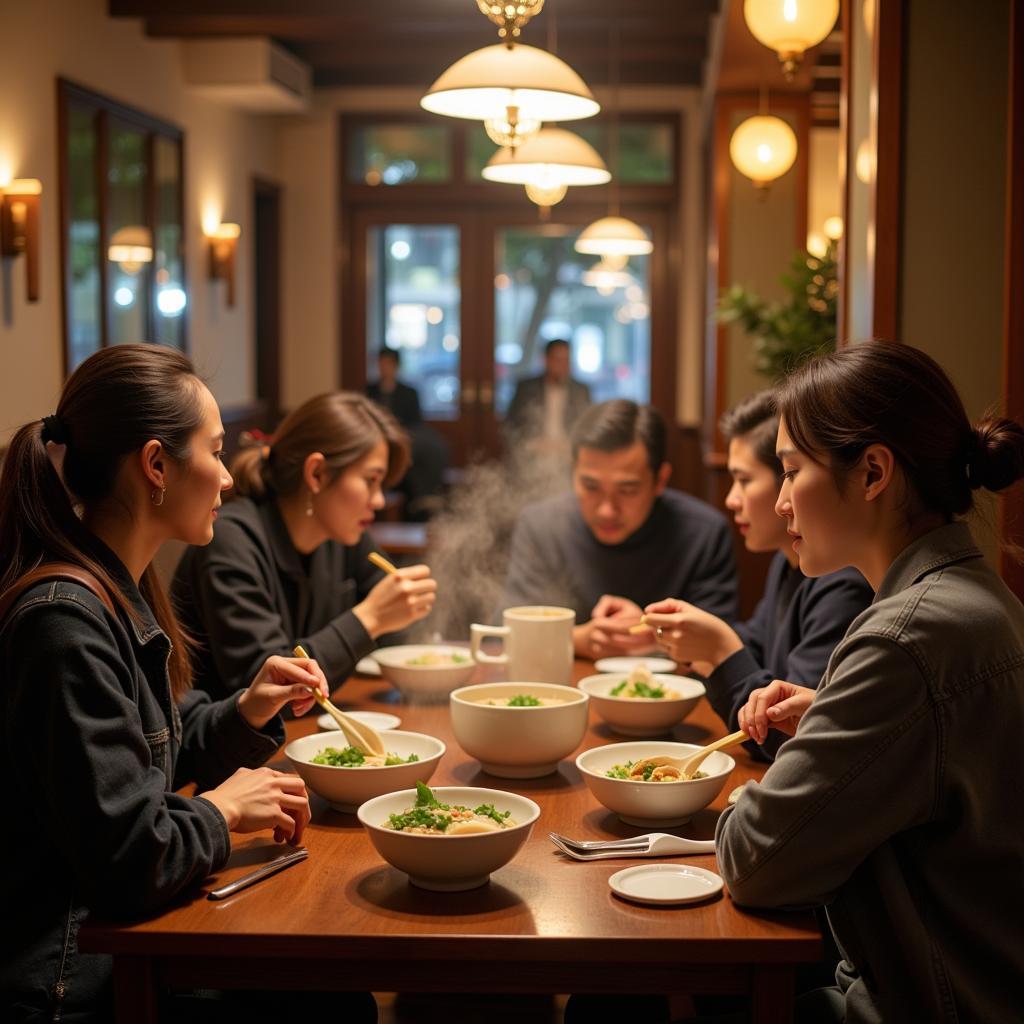Pho, a staple in Vietnamese cuisine, is more than just a soup; it’s a cultural experience. This aromatic and flavorful dish has captured the hearts (and stomachs) of people worldwide. From its humble beginnings to its international acclaim, let’s dive deep into the world of pho and discover what makes it so special.
The History and Cultural Significance of Pho
Pho’s origins are shrouded in a bit of mystery, with various theories about its exact beginnings. Some believe it emerged in the early 20th century in northern Vietnam, possibly influenced by French and Chinese culinary traditions. Others suggest its roots lie in the earlier Vietnamese dish “xáo trâu,” a water buffalo soup. Regardless of its precise origins, pho quickly became a beloved national dish, a symbol of Vietnamese culinary identity.
Pho is traditionally eaten for breakfast or as a light lunch. It’s a communal dish, often shared with family and friends, fostering a sense of connection and belonging. Street vendors selling steaming bowls of pho are a common sight throughout Vietnam, their fragrant broth permeating the air. It’s a truly immersive sensory experience.
Deconstructing a Bowl of Pho: Ingredients and Preparation
What makes pho so uniquely delicious? It’s the harmonious blend of carefully selected ingredients and a meticulous preparation process. The foundation of pho lies in its rich broth, simmered for hours with beef or chicken bones, charred onions, ginger, and a blend of spices like star anise, cinnamon, and cloves. These aromatic spices infuse the broth with depth and complexity.
The noodles, typically flat rice noodles, are added to the bowl along with thinly sliced beef (phở bò) or chicken (phở gà). The final touch is a generous garnish of fresh herbs like basil, cilantro, and mint, bean sprouts, lime wedges, and chili slices, allowing each diner to customize their bowl to their liking.
Regional Variations of Pho
While the basic principles of pho remain consistent, regional variations exist throughout Vietnam. Northern pho tends to have a clearer, simpler broth, emphasizing the pure flavors of the beef or chicken. Southern pho often incorporates sweeter notes and a wider array of toppings, such as tendon, tripe, and meatballs. Exploring these regional variations is a culinary adventure in itself.
Where to Find Authentic Pho in Hanoi
Hanoi, the capital of Vietnam, is a pho lover’s paradise. From bustling street food stalls to established restaurants, you can find countless variations of this iconic dish. Some renowned pho spots in Hanoi include Phở 10 Lý Quốc Sư, Phở Bát Đàn, and Phở Thìn. Each establishment has its unique take on pho, showcasing the diversity and richness of this culinary gem. And with TRAVELCAR’s convenient car rental services, exploring these culinary hotspots is easier than ever. We offer a range of vehicles, including 16-seater, 29-seater, and 45-seater buses, perfect for group tours. Contact us at 0372960696, email us at [email protected] or visit our office at 260 Cầu Giấy, Hà Nội for more information.
 Enjoying Pho at a Restaurant in Hanoi
Enjoying Pho at a Restaurant in Hanoi
Conclusion: A Taste of Vietnam in Every Bowl
Pho is more than just a meal; it’s a cultural immersion, a culinary journey that tells the story of Vietnam. From its rich history to its diverse regional variations, pho offers a unique and unforgettable experience for every palate. So, next time you find yourself craving a taste of Vietnam, seek out a bowl of this aromatic and flavorful soup and savor the essence of Vietnamese cuisine.
FAQ
- What is the difference between pho bo and pho ga? Pho bo is made with beef, while pho ga is made with chicken.
- What are the common toppings for pho? Common toppings include basil, cilantro, mint, bean sprouts, lime wedges, and chili slices.
- Where can I find good pho in Hanoi? Hanoi offers numerous pho restaurants and street food stalls. Some popular choices include Phở 10 Lý Quốc Sư, Phở Bát Đàn, and Phở Thìn.
- Is pho spicy? Pho itself is not inherently spicy, but you can add chili to your liking.
- What is the best time to eat pho? Pho is traditionally enjoyed for breakfast or lunch.
- Can I find vegetarian pho? Yes, vegetarian pho options are becoming increasingly available, often using tofu or mushrooms as a protein substitute.
- What is the average cost of a bowl of pho in Hanoi? The cost of a bowl of pho varies depending on the location, but it’s generally very affordable.
Need assistance? Contact us at Phone: 0372960696, Email: TRAVELCAR[email protected], or visit us at 260 Cầu Giấy, Hanoi. We have a 24/7 customer support team. Explore other articles on our website about Vietnamese cuisine and travel tips.